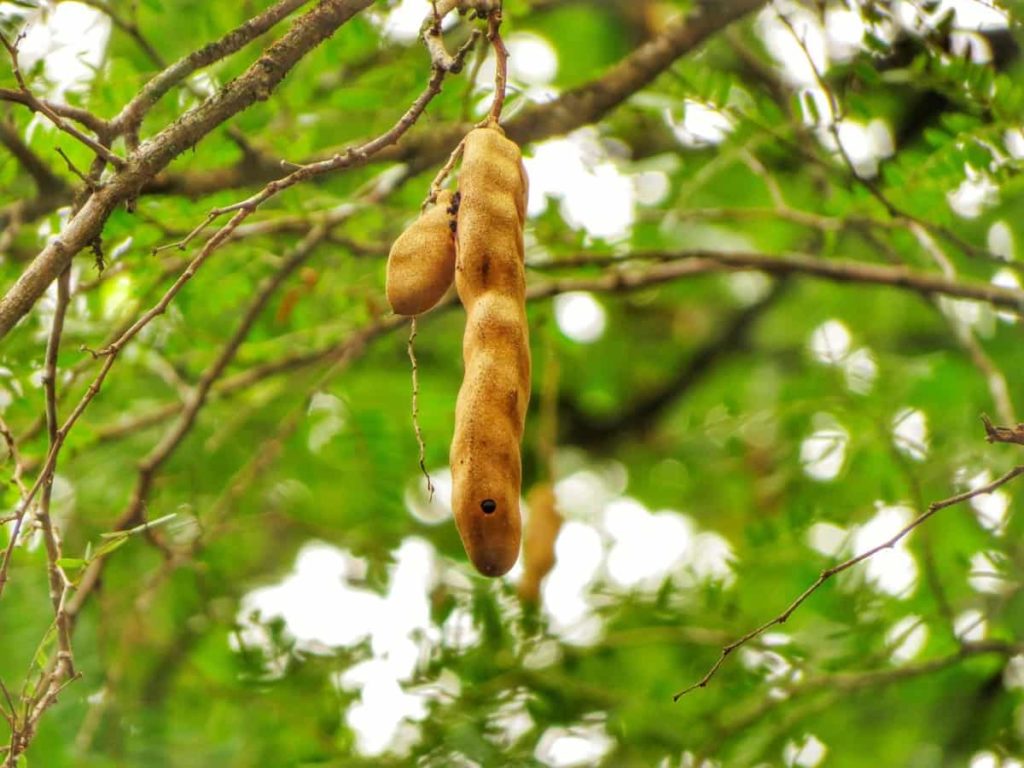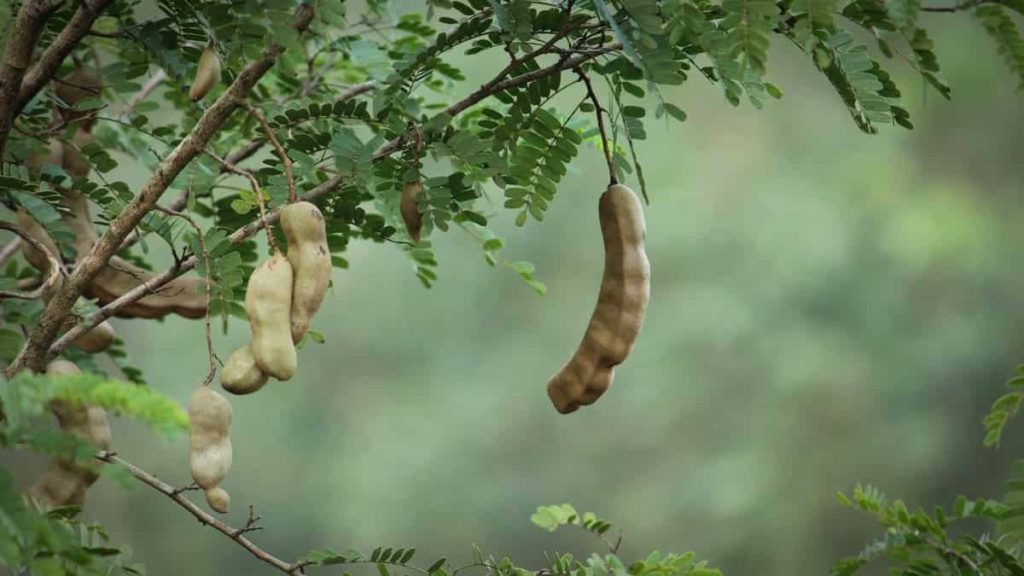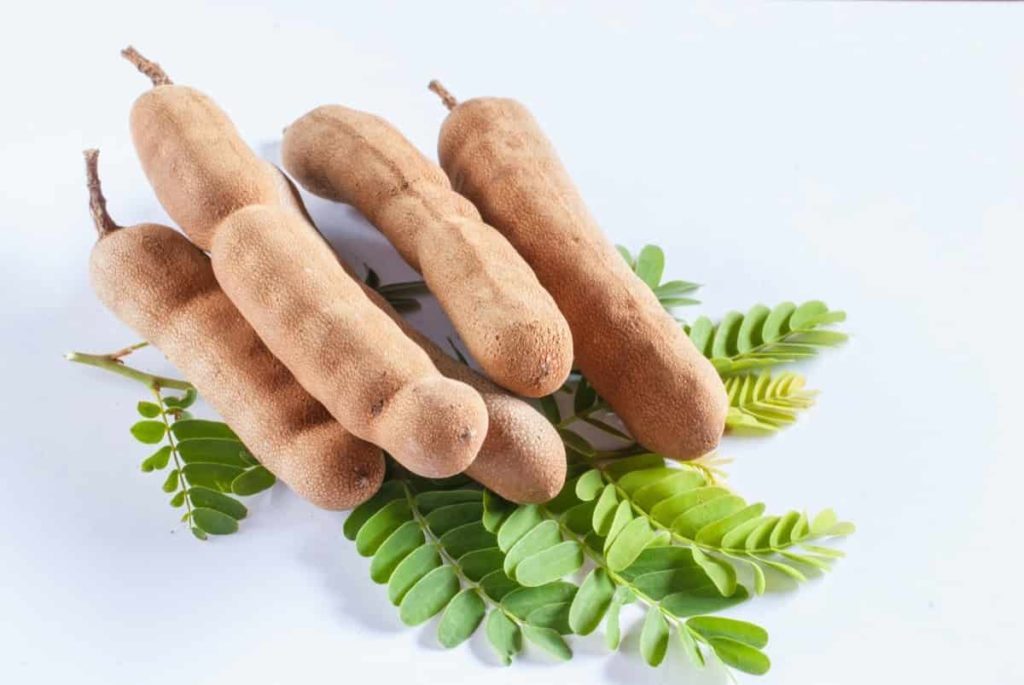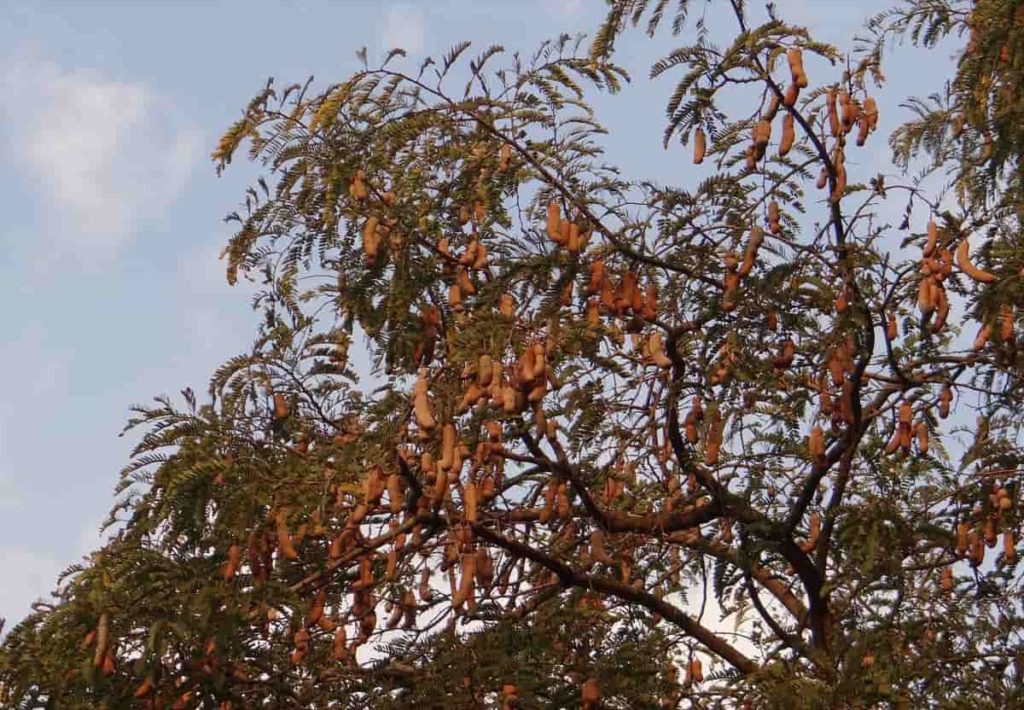Tamarindus Indica, called tamarind in general, is a tropical fruit plant that roots in Africa but is extensively grown in all the tropical regions of the Indian subcontinent. Its fruits taste sour and have a unique aesthetic design where the pods produced are a seed-like chain with a fibrous pulp surrounding the set of seeds. The color of the pod changes along with the color of the pulp as it grows old, from thick fresh green to brownish color resembling that of dates. Let’s check out the best practices to grow Tamarind trees below.

Tamarind is also known as the date of India. Tamarind offers numerous health benefits, thanks to its rich nutrient content and abundant citrus levels, which boost the immune system. Additionally, even tamarind seeds are edible and are used in various applications. The pulp is extensively used for cooking in Asian countries, Mexico, and Middle Eastern regions on a large scale in making sauces, drinks, chutneys, and even desserts.
Indians have a particular tradition of consuming tamarind at a specific time of the year when according to history, the old new year begins. Tamarind has an excellent domestic market throughout the year due to its demand irrespective of the season. This is why farmers extensively use tamarind farming for good commercial choice. Below are some common queries regarding tamarind agriculture in backyards or fields.
Best practices to grow Tamarind trees
How many years does it take to grow a tamarind tree?
- The time taken for a tamarind tree to grow and bear fruits will depend on the method of cultivation or growing used. If the plant is developed from the seed stage, it will take well over 7-8 years for the plant to bear fruits.
- If the plant is produced by grafting alternately, after 4-6 years, the plant can be witnessed yielding its first fruit.
- Irrespective of the time taken to grow fruits and the plant’s age, harvesting is primarily done in March and April.
In case you missed it: Common Sheep Diseases, Symptoms, and Treatment: Check How this Guide Helps Sheep Farmers

In which season is tamarind grown?
- The planting time is taken care of while the plant is first placed in the soil. After that, the plant grows for 4-8 years, depending upon the method of cultivation employed.
- After the plant grows enough to bear fruits, the yield is obtained almost every season, but the most quality fruits are harvested in March and April.
- The time can be described in a generalized manner as the onset of summer, at the earliest rise of temperatures.
How many years do tamarind trees live?
- The average lifespan of a healthy tamarind plant is no less than 200 years. Tamarind thrives a long life and is often seen in villages growing from generation to generation, offering food, shade, and benefits.
- If any fencing does not restrict the plant, it would spread wide and grow even longer due to the extra support from the ground.
Can tamarind grow from cuttings?
- Usually, trees are grown in vegetative methods or from seeds, where the vegetative methods involve cuttings. One such method is grafting, where a branch of one plant is planted in the soil, suitable manure is given, and a new plant is obtained.
- Tamarind has excellent growing capabilities and grows equally well from grafting and traditional method of seeds.
- The method of growing either by seedlings or by vegetative practices depends upon the geographic conditions and the type of soil at the cultivation site. This is again decided only after the soil test and the nutrients and productivity levels are checked.
- Grafting and air layering are usually the most used vegetative methods employed if the seedling method is unsuitable. The time taken for the plant to yield fruits is minimized to 4-6 years when grown in vegetative methods, and this is preferred for economical harvesting by commercial farmers.
- Orchards are established in extensive lands with fertile soil and excellent manure from natural composts and fertilizers.
In case you missed it: Best Practices to Grow Taro Root at Home: Check How this Guide Helps Beginners

How tall do tamarind trees grow?
- Tamarind trees grow huge compared to other similar trees. They can grow from 10 meters to 18 meters in case of healthy growth and proper ground soil.
- The height changes with changes in geographical locations along the tropical region. In India, most trees grow to 10-12 meters.
How much water do tamarind plants need?
- By true nature, the tamarind plant is a rainfed dry season plant. Therefore, it does not require more water to survive than natural groundwater and rainwater. However, freshly planted seeds do need to germinate and grow seedlings faster. Therefore, this watering is only done in extremely dry conditions and during the summer months.
- The water quantity required is around 10 liters once a week for one-year-old trees, which is doubled for the next year, similarly to other years. However, after the plant grows adeptly for close to 4 years, irrigation would not be necessary other than rainwater.
- The growth rate of plants can be boosted by additional water supply to the early growing plant, which can also help strengthen the root system. But care is to be taken not to overdose the plant on water.
Where can you grow tamarind?
- Tamarind plant can thrive on various kinds of soils as it is mainly dry and does not demand many conditions in the ground to grow. Therefore, the only requirement for the plant is the nutrition levels of the soil to be rich enough to allow the plant to produce its tap roots to maximum depths and enable plant growth.
- Deep loamy soils and alluvial soils are best recommended for planting tamarind seeds to yield the best and healthy. Even then, there are other factors like soil pH to take care of. Tamarind seedlings thrive best in slightly alkaline soil, with a slight hint of salinity.
In case you missed it: Common Dairy Cattle Diseases, Symptoms, and Treatment: Check How this Guide Helps Dairy Farmers

How do I get my tamarind plant to bear fruit?
- Tamarind plants bear fruits during the early onset of summers, most likely in March, after which harvesting is done in March and April. Adding organic fertilizer and manure can support and improve the fruiting duration.
- A mixture of Nitrogen, Phosphorous, and Potassium in a ratio of 6-6-6 can be applied to the young plants for 2-3 months in the summer season.
- This mixture can be varied for mature plants in a range of 8-3-9 occasionally to promote the early fruiting in mature seeds. Developed plants usually do not require additional fertilizers.
How long do tamarind seeds take to germinate?
- Tamarind seeds are soaked in warm water overnight and placed in soil around half an inch deep, ensuring good manure. Regular watering can ensure the germination of seedlings in 2-3 weeks.
- Though the seeds germinate quickly enough, the time taken for the plant to develop to a fruiting stage is no less than seven years through seed cultivation.
In case you missed it: Best Practices to Grow Sweet Potatoes at Home: Check How this Guide Helps Beginners

How do you take care of the tamarind plant?
- Young tamarind plants require particular special care for better growth and yield. Tieing them up with a bamboo stick for support would be best, along with proper manure, and regular watering would boost the development of the seedling.
- In the juvenile period, plant growth is trained concerning farm work. The diseased roots appearing from lower branches and other areas must be removed.
- The plant has a naturally strong immune system and is not prone to any disease considerably to date. Studies also do not show any signs of serious diseases that have attacked the tamarind plant.
What is the stepwise procedure to grow tamarind?
- The procedure for growing tamarind is relatively simple. It can be produced from both seeds and vegetative methods like grafting etc. The yielding time for the plant grown from seeds is 7-9 years, whereas the plant from vegetative methods can be obtained within four years. Any process begins by selecting the appropriate cultivation site with the proper soil required for the plant to thrive.
- Loam soil with deep roots for the tamarind plant to grow and spread is selected along with natural compost manure to boost germination. The next step is to obtain quality seeds and germinate them.
- Quality seeds are obtained from trusted seed vendors and soaked in water overnight before being placed in the soil. This process is called Priming of the sources, which initiates the process of seed germination more quickly than in average seeds which are not soaked. Then, the soaked seeds are placed in soil to a depth of 0.5 inches and, with good dirt, covered to protect from erosion.
- In the initial days, close to one year, the seed is watered at a rate of 5-6 liters per week; after one year, the quantity is increased to 10 liters per 8 days. This quantity is further doubled in the second and third years, after which watering is mostly unnecessary.
- Organic fertilizers as a mixture of N, P, and K in combinations of 6 parts each are provided to the soil in the initial stages of plant growth for about three years. However, after three years, fertilization as a mixture of 8-3-9 is rarely provided in dry seasons to ensure timely plant fruiting.
- The plant takes a minimum of 7 years to grow to the stage of fruit yielding when grown from seeds, whereas when grown from vegetative practices, it takes four years. Harvesting is done mainly in March and April, but these standards would vary from various geographical locations with different climatic conditions.
- Whether cultivating in vegetative method or traditionally through seeds, care is to be taken when the plant grows. A bamboo stick must be tied along as a support for the young plant to begin to rise. This can be removed after the plant can balance on its roots.
In case you missed it: Best Practices to Grow Green Chilli (Mirchi): The Best Guide for Beginners

Conclusion
While tamarind plants grow as tall as 18 to 20 meters, the wood it offers is equally in demand with the fruit’s pulp. The initial fruit develops pulp green in colour with a stringent sour taste, which later develops into maroon and brown, red pulp of mature sourness. Tamarind is a popular member of the Indian cookery practices where it is used in various ways like sauce making, soups as a side dish or combination, or even in pickles.
Along with this, tamarind pulp is used to clean harsh stains that are stuck on household utensils. Tamarind is highly rich in citrus values and nutrients, which offer high immunity-boosting abilities and can help improve blood clotting abilities. Even women consume tamarind when having pregnancy-related issues.
While there are good positive aspects and benefits of tamarind, there are negative aspects too, like tooth damage in case of excess consumption, causing skin diseases and issues like ringworms, and even fainting at times. Hence, one needs to properly balance tamarind intake in one’s body while also consuming complementary foods. These were some of the common queries related to the farming of tamarind.
- How to Raise Pigs in Your Own Backyard: A Comprehensive Guide
- Budget Friendly Sheep Shed Ideas: Cheap and Low-Cost Tips
- How Much Do Cattle Farmers Make: Revenue Streams in Cattle Farming
- Management Pests and Diseases in Your Cotton Field
- Sheep Farming Business Plan for Beginners
- Aquaponic Farming at Home: A Step-By-Step Guide
- Profitable Village Farming Business Ideas in 2024
- High-Yield Aquaculture: Fast-Growing Fish for Farming
- Effective Fish Pond Construction Techniques for Beginners
- Irrigation and Water Management in Pineapple Farming
- Blossom to Harvest: Mastering Flowering and Pollination in Papaya Farming
- Pig Fattening Essentials: From Selection to Sale for Beginners
- Raising Wagyu Cattle: A Complete Guide for Premium Beef Production
- Soil Types and Their Water Holding Capacity
- Optimizing Irrigation Schedules for Coconut Groves for Enhanced Yield
- Espresso Your Garden: Coffee Grounds for Healthier Acid-Loving Plants
- The Best Soil Mix for Snake Plants: How to Mix Your Own Snake Plant Soil
- Green Thumb Success: Expert Tips for Cultivating Greenhouse Beans All Year Round
- Bloom All Year Round: The Ultimate Guide to Indoor Hyacinth Care
- Eco-Friendly Gardening: How to Make Liquid Fertilizer from Kitchen Waste
- Ultimate Guide to Grow Anise in Pots: Explore Seed Propagation to Harvesting
- Guide to Raising Chester White Pigs: Discover Breed Facts to Growth Management
- Mastering the Elegance: The Ultimate Guide to Weeping Cherry Tree Care, Planting, and Maintenance
- Ultimate Guide to Planting Garlic in Grow Bags: Growing Strategies for Beginners
- How to Fix Spider Plant Leaf-Related Problems: Natural and Organic Remedies
- 10 Reasons Why Your Tulsi Plant is Shedding Leaves: Home Remedies and Solutions
- Optimizing Growth and Yield: The Advantages of Palm Bunch Ash Fertilizer
- Utilizing Neem Oil Extract as a Natural Pesticide for Hydrangea
- From Soil to Harvest: Various Ways in Which Farmers Can Use AI Tools
- Steps to Encourage and Induce Citrus Flowers: A Comprehensive Guide
- How to Fix Snake Plant Leaf-Related Issues: Natural and Organic Remedies
- Transform Your Garden into a Fragrant Oasis with Raat Ki Rani (Night Blooming Jasmine)
- Discover the Ideal Chicken Breeds for Philippine Farms
- How to Create a Poultry Egg Farm Business Plan for Profits
- Grow Lemon Cucumbers Like a Pro: Insider Techniques for Bountiful Yields
- Ultimate Guide to Caring for Your Pink Princess Philodendron: Tips for Thriving Variegation
